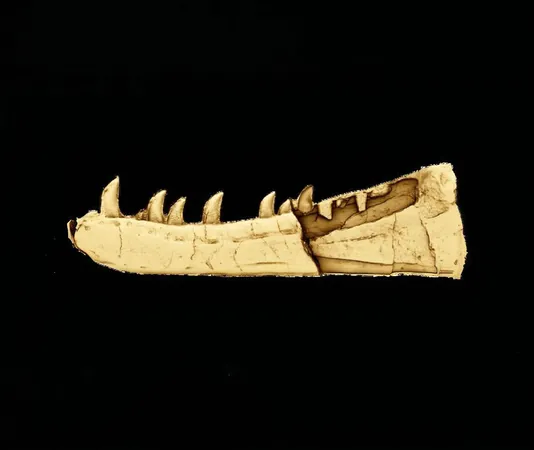
Groundbreaking Laser Technique Unveils 20 Hidden States of Matter in Quantum Physics
2025-09-15
Author: Emma
A New Frontier in the Quantum Zoo
The quantum world just got a lot more fascinating! Researchers have unveiled nearly 20 hidden states of matter using an innovative laser technique, greatly expanding what scientists refer to as the "quantum zoo." This groundbreaking discovery could be pivotal in the development of next-generation quantum computers.
The newly discovered states reside within a material known as twisted molybdenum ditelluride (tMoTe₂) and intriguingly don’t need an external magnet to manifest.
From Theory to Reality
Published in the scientific journal Nature, this finding marks a significant milestone in the decades-long quest to identify exotic forms of quantum matter. Traditionally, scientists have predicted these states through theoretical frameworks and simulations, but until now, confirming their existence in real-world materials remained elusive.
Led by Xiaoyang Zhu from Columbia University, this collaborative effort finally brings these abstract theories into the observable realm. Zhu expressed astonishment at the abundance of newly observed states: "Some of these states have never been seen before—and we didn’t expect to find so many!"
Understanding the Fractional Quantum Anomalous Hall Effect
At the heart of this discovery lies the fractional quantum anomalous Hall effect. To grasp this phenomenon, one needs to understand its historical context, beginning with the classical Hall effect, discovered in 1879. This effect illustrates how electrons shift towards the edges of a metal strip in the presence of a magnetic field, generating a measurable voltage.
Delving deeper, when this experiment is conducted at ultra-low temperatures in two dimensions, the quantum Hall effect emerges—showing that voltage changes happen in fixed increments. Sometimes, these increments take even more peculiar forms, leading to what’s known as the fractional quantum Hall effect, a discovery so significant it earned Columbia’s Horst Stormer a Nobel Prize in Physics in 1998.
A Game-Changer: No Magnets Required
The twist? The anomalous effects seen in twisted molybdenum ditelluride can occur without any external magnets. This was a remarkable finding made by physicist Xiaodong Xu at the University of Washington, who with a team from Cornell and Shanghai Jiao Tong University, discovered that twisting ultra-thin layers of molybdenum ditelluride into a specific configuration, known as a moiré lattice, could generate the fractional quantum anomalous Hall effect without magnets.
Innovative Laser Technique Uncovers Hidden Details
In a fascinating stroke of luck, Yiping Wang, a postdoctoral fellow at Columbia, utilized a cutting-edge method called pump-probe spectroscopy on a sample of twisted molybdenum ditelluride while Zhu was traveling. This technique employs twin laser pulses—one to excite electrons and the other to measure how these states evolve over time.
The results were astounding, revealing energy levels corresponding to fractional fillings like -4/3 and -3/2, which had existed only in theoretical predictions. These fractional states are prime candidates for exotic quantum phases that could revolutionize stable topological quantum computing.
A Wealth of New Discoveries Await
Not only did the team confirm known states, but they also identified nearly 20 new ones, including fractional fillings between 0 and -1. Among the most intriguing are the fractional fillings of Chern bands, which could potentially house non-Abelian states—an unusual class of quantum matter crucial for error-resistant quantum computing.
Why This Discovery Matters
There’s more to this discovery than merely expanding the quantum zoo. The experiment also revealed how these correlated quantum states break apart and recover on different timescales, emphasizing the distinct processes at play.
The fractional quantum anomalous Hall effect provides greater potential for practical quantum technologies, especially as it allows for the creation of quantum states free from the interference typically caused by magnets.
The Quantum Zoo is Expanding
While the term "quantum zoo" may seem whimsical, it reflects the profound excitement in quantum physics as researchers continue to unveil previously unobserved states. The recent findings in twisted molybdenum ditelluride not only enrich our understanding of quantum mechanics but pave the way for future technological advancements. As scientists delve deeper, who knows what other magical creatures will be discovered in this quantum zoo?









 Brasil (PT)
Brasil (PT)
 Canada (EN)
Canada (EN)
 Chile (ES)
Chile (ES)
 Česko (CS)
Česko (CS)
 대한민국 (KO)
대한민국 (KO)
 España (ES)
España (ES)
 France (FR)
France (FR)
 Hong Kong (EN)
Hong Kong (EN)
 Italia (IT)
Italia (IT)
 日本 (JA)
日本 (JA)
 Magyarország (HU)
Magyarország (HU)
 Norge (NO)
Norge (NO)
 Polska (PL)
Polska (PL)
 Schweiz (DE)
Schweiz (DE)
 Singapore (EN)
Singapore (EN)
 Sverige (SV)
Sverige (SV)
 Suomi (FI)
Suomi (FI)
 Türkiye (TR)
Türkiye (TR)
 الإمارات العربية المتحدة (AR)
الإمارات العربية المتحدة (AR)